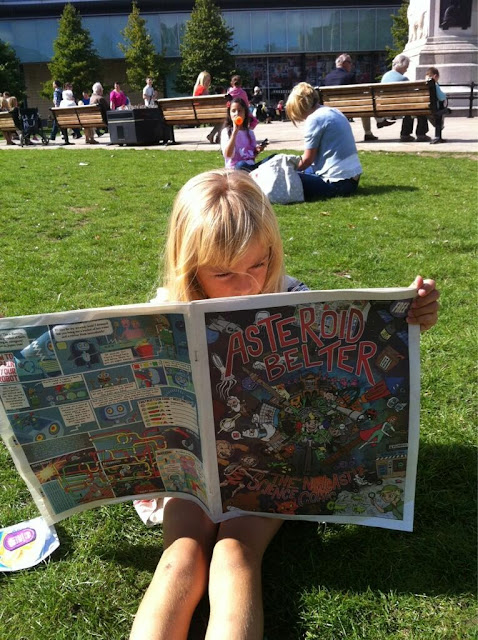One of our favourite things about this project has been the chance to share big ideas that don't normally reach younger audiences. Everything's Connected, drawn by Terry Wiley, with science from David Alderson is a huge idea. From flushing the loo or turning on a light to whether your train arrives on time, it's all connected, with all the disruptions possible I'm surprised any of this works at all. So let's have David introduce himself and tell us a bit about what he does...
My name is David Alderson, and I have been working as a
researcher in GeoInformatics at Newcastle University since 2005. Geomatics,
geoinformatics and many derivatives thereof in general refers to the study,
measurement, and management of earth-related things. Think Google Earth, and
you are nearly there. It could include monitoring biodiversity by collecting
crowd-sourced data on species sightings, developing models of infrastructure
networks for failure analysis, to delivering web sites and web services for
people to get access to spatial data. This data comes in many forms, from GPS
positions, detailed land and building surveys, satellite imagery and aerial
photography – with the one thing they have in common being that they are all
related to the Earth, and position on the Earth.
In the past I have worked largely to manage, store and then
deliver, mainly via geospatially-enabled websites, spatial data of all kinds. A
couple of projects that I have been involved in involve crowd-sourcing data to
help validate flood models and collect experiences of flood events, to collecting
species sightings around the North East of England. I have worked with the Met
Office, Department for Environment, Food and Rural Affairs (DEFRA), British
Atmospheric Data Centre (BADC) and many others to help deliver the latest
climate change projections, back in 2009. As climate change is largely accepted
by all in the scientific community as a genuine challenge facing mankind over
the next 10, 20, 50, 100 years and beyond, the tools and websites that I have
been involved in developing, help to disseminate data that can aid decision
makers to make better informed decisions. This is particularly important, for
example, when considering what types of energy-generation technologies to
invest in, or what carbon reduction strategies to employ. My current research,
and largely the inspiration for getting involved in the comic, is focussed on
the modelling, study and analysis of traditional infrastructure networks
including roads, rail, energy, water and solid waste. We are trying to
understand how infrastructure networks are affected by climate-related hazards,
such as flooding, but then also understand how the supply and demand for
infrastructure services will change over the next 100 years as the economy and
population changes.
Comics excite me both because they are so much fun to read
but can feasibly by focussed around any topic imaginable. When speaking with
the artists and writers during the production of the comic, the alternative
ways of portraying a specific idea seemed endless, and often presenting
information in such different ways can lead to a better understanding of patterns,
or identification of other interesting artefacts. I think the idea of joining
up science and research within the comic medium for communication offers a
completely different mechanism for disseminating concepts, ideas, research,
data to the general public and other researchers. Scientists in academia are
largely judged by their ability to, and frequency with which they, publish in
peer-reviewed journals about their specific subject. However these are not
necessarily easily-accessible to the general public or children alike, despite
the proliferation of open access publishing and the accessibility offered by
web-based publishing. The use of a comic as an alternative method brings in an
element of fun to scientific research, and ultimately that is probably the best
way to attract children and teenagers to becoming interested in science – BY
MAKING IT FUN!
Email:
David.Alderson@ncl.ac.uk
More information about some of the work that I have been
involved in at Newcastle University, and also some of the work that the
Geospatial Engineering, Geodesy and School of Civil Engineering at Newcastle
have undertaken and are currently involved in can be found from the following
links:
Specific websites related to my work:

















